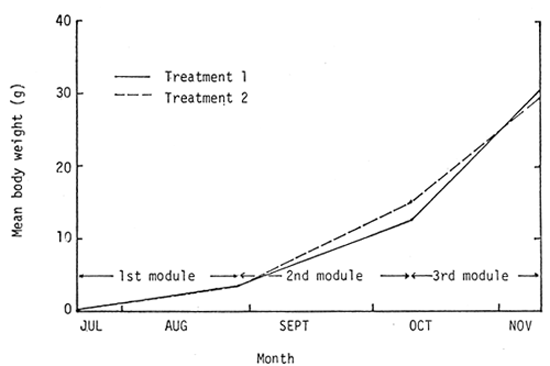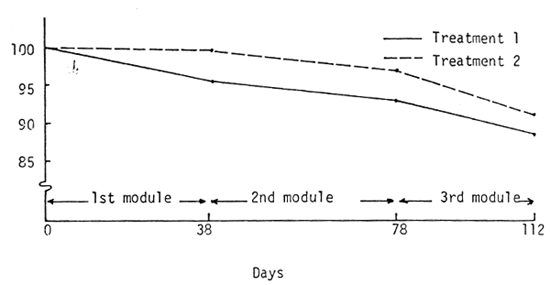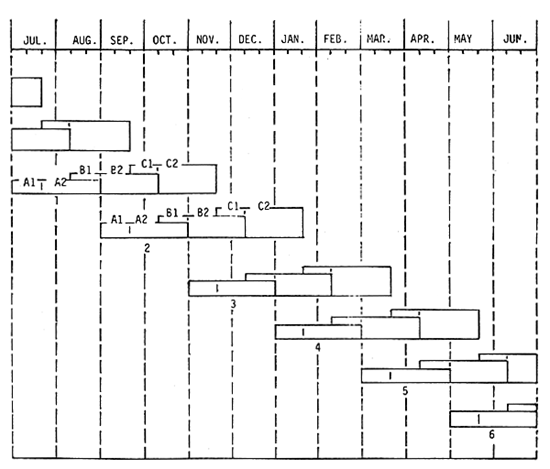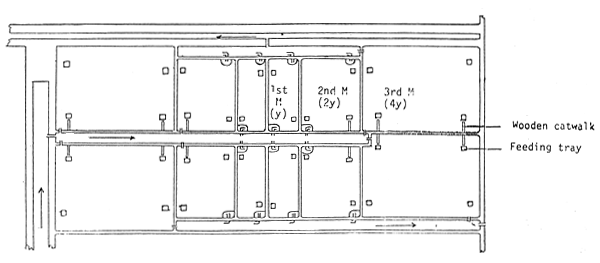
Using the Modular Pond System
| NACA/WP/87/59 | June 1987 |
 |
PRODUCTION OF PRAWN (Penaeus monodon Fabricius) Using the Modular Pond System |
by
Pudjiatno
Dan B. Baliao
Network of Aquaculture Centres in Asia
Bangkok, Thailand
June 1987
Hyperlinks to non-FAO Internet sites do not imply any official endorsement of or responsibility for the opinions, ideas, data or products presented at these locations, or guarantee the validity of the information provided. The sole purpose of links to non-FAO sites is to indicate further information available on related topics.
This electronic document has been scanned using optical character recognition (OCR) software. FAO declines all responsibility for any discrepancies that may exist between the present document and its original printed version.
This study was conducted to evaluate survival, growth, production, food conversion and economic feasibility in the monoculture of prawn (Penaeus monodon) at two stocking densities (15,000 juv/ha and 20,000 juv/ha) following modular pond system. Four sets of existing modular ponds at SEAFDEC, Leganes Research Station were used for this study. Each set forms a three-stage link-up. The area of each set is increasing progressively in a ratio of 1:2:4 proportion or a corresponding ratio of 550, 1100 and 2,200 m2 respectively. Using this method, prawns were grown and were provided a better utilization of space and increased number of croppings (six crops a year) than previously realized in straight-run culture. On Treatment 1 and Treatment 2 growth, survival rate and final body weight of the prawn showed that there were no significant differences between the two treatments. Observed significant differences was on greater average production of the prawn achieved which was 533 kg/ha in Treatment 2 than 404 kg/ha production in Treatment 1. Economic analysis for Treatment 1 and Treatment 2 showed that returns on investment were 69.5 and 72.0%; the payback periods were 1.4 and 1.3 years, respectively.
1 Brackishwater Aquaculture Development Centre, Jepara, Indonesia
Brackishwater prawn (Penaeus monodon) culture has developed tremendously in the past few years due to a constant increase in prawn demand and limited supply in the world market. Aquaculturists have tried to increase the production of prawn. Improvements in pond design and layout for prawn culture, have gradually evolved. Thus, stocking density could be increased with the aid of aeration. Therefore, growth rates of the prawn could be increased and production can also be raised.
The modular system is an advanced method in prawn culture and it has potential in the development of prawn culture. Usually, the modular or progressive pond culture system has been identified only with milkfish (Chanos chanos), like culture of milkfish in Indonesia, Philippines and Taiwan (Lijauco et al, 1979).
Parker (1974) reported a production module designed to provide a maximum member of crops per season and more efficient utilization of space than previously realized in single pond units. Chamberlain (1981) found that comparison of survival, growth, production and value in the three-phase system (modular system) versus single-phase system (straightrun system) to be similar between systems. Baliao (1985) observed that by following the modular systems, prawn production would be increased by 6 crops a year. In the same process, there was accurate accounting of stock and computation of feeding rates. Also, limitation of unwanted species was facilitated.
This study was conducted to evaluate survival, growth, production. feed conversion and economic feasibility in the monoculture of prawn (P. monodon) at two stocking densities (15,000 juveniles/ha and 20,000 juveniles/ha) following the modular pond system.
This study was conducted from July 20 to November 10, 1986 at Leganes Research Station, SEAFDEC Aquaculture Department, Iloilo, Philippines.
Four sets of existing modular ponds at SEAFDEC-LRS were used for this study. Each set forms a three-stage link-up. The area of each set is increasing progressively in a ratio of 1:2:4 proportion or a corresponding ratio of 550,1100 and 2200 m2, respectively. A completely randomized design with 2 treatments and 2 replicates was followed (Table 1).
Table 1. Random selection of 2 treatments and 2 replicates on the modular experiment pond.
| TREATMENT | REPLICATE | STOCKING DENSITY (juv/ha) | MODULAR SET | |
| 1 | 1 | 15,000 | B | B1, B2 and B3 |
| 2 | 15,000 | C | C1, C2 and C3 | |
| 2 | 1 | 20,000 | A | A1, A2 and A3 |
| 2 | 20,000 | D | D1, D2 and D3 | |
The modular experimental ponds were constructed with peripheral canals (150 cm wide and 20 cm deep) for refuge during warm water condition, transfer and harvesting of stock and ease in water management. Standpipe gates (16 cm diameter) and concrete slices were provided with fine mesh (1 mm) nylon and bamboo screens. Feeding trays (80 × 80 cm) made of nylon screen (1.5 mm mesh size) and frame with bamboo splits were provided. Also, wooden catwalks were installed at strategic corners or sides of the pond to facilitate feeding.
Prawns were grown and moved periodically from one module to the other, taking 4 to 6 weeks in each module until they reached marketable size within 12 to 18 weeks.
All activities in the modular pond culture experiment are shown in Table 2.
Table 2. Description of activities on the modular culture experiment
| ACTIVITIES | DATE OF ACTIVITIES | ||
| 1st Module | 2nd Module | 3rd Module | |
| 1. Draining the pond | July 1 | August 11 | September 17 |
| 2. Levelling of the pond bottom | July 3 | August 12–13 | |
| 3. Drying the pond bottom | July 3–11 | August 13–19 | Sept 18-Oct 12 |
| 4. Eradication of unwanted species | July 7 | August 14 | September 25 |
| 5. Application of chicken manure | July 7 | August 15 | September 26–28 |
| 6. Installtion of nylon screen | July 8–9 | August 16–17 | September 29 |
| 7. Installation of Aviscennia spp. twigs | July 10–11 | August 18–19 | Sept 20-Oct 2 |
| 8. Admit water | July 12 | August 20 | October 3 |
| 9. Stocking | July 20 | August 27 | October 7 |
| 10. Water management | July 22–25; | Sept. 3–6; | Oct. 8–11; |
| Aug. 5–8; | Sept. 9–12; | Oct. 19–23; | |
| Aug. 19–22; | Sept. 16–19; | Nov. 2–4 | |
| Oct. 2–4 | |||
| 11. Water monitoring1 | twice a week | twice a week | twice a week |
| 12. Feeding | everyday (7:00 AM & 5:00 PM | everyday (7:00 AM & 5:00 PM) | everyday (7:00 AM & 5:00 PM) |
| 13. Sampling | August 27 | October 7 | November 10 |
| 14. Transferring | August 27 | October 7 | November 10 |
| 15. Harvesting | November 10 | ||
Pond Preparation
Prior to stocking, renovation of peripheral canal in each module was made. The canal system facilitates harvest or transfer of stock and likewise renders ease in water management. All compartments were prepared following the “lab-lab” method of growing natural food in pond. Levelling, draining and drying the pond bottom to crackness was done in order to maximize production area and to release obnoxious gases, respectively. Application of a combination of lime (CaO) at 1000 kg/ha and ammonium sulfate (21-0-0) at 200 kg/ha was followed in order to get rid of unwanted species. Also, chicken manure as organic fertilizer was broadcasted on the pond bottom about 2000 kg/ha.
Artificial substrates (Aviscennia spp.) twigs were installed across the pond bottom to increase surface area for attachment of fry and natural food organisms. A week before stocking, the ponds were filled with seawater gradually to allow for growth of “lab-lab” as a natural food.
Stocking
Juveniles that had been cultured for 30 days in the adjacent nursery pond were used in this study. Before stocking, the juveniles were placed in plastic basins to facilitate counting or sorting out unwanted species. It was not necessary to acclimate that juveniles from nursery to modular pond because both water temperature and salinity were the same at 27°C and 200 ppt. The juveniles were stocked directly into the pond early in the morning of July 20, 1986. Ponds B and C were stocked with 5775 juveniles each, which was assigned with 15,000 juv/ha (Treatment 1). Ponds A and D were stocked with 7000 juveniles each which was assigned with 20,000 juv/ha (Treatment 2).
Water Management
After stocking, the primary concern was to keep the water condition favorable for both the fry and the natural food particularly in the first module. Dikes, gates and screens were regularly inspected to prevent excessive loss of water due to leaks and seepages. Whenever possible, water was renewed specially during long summer months to prevent salinity increase to unfavorable levels. Prawns are observed to grow faster in warm water between 26 to 30°C and water salinity of 6 to 33 ppt (Motoh, 1981).
Water renewal was performed by draining about one third during low tide and reflooding gradually during spring tide. It was done about 3 to 4 times every spring tide. Low saline water was drawn from the drain canal that was connected to the Jalaur River.
Feeding
Prawns were fed with frozen trash fish (wet weight) twice a day. It was chopped and given by tray and broadcast methods. Feed amounts for each module at 30, 24 and 18% of total body weight were adjusted after each sampling period based on new survival and growth of the prawn. One half of the feeding requirement was given early in the morning (7:00 to 8:00 AM) and the other half in the evening (5:00 to 6:00 PM).
Sampling, Transfer and Harvest
Salinity, temperature, pH, dissolved oxygen (DO) and water depth were recorded twice a week between 7:00 and 8:00 AM.
Survival was determined by collecting and counting all prawn individually harvested from 1st, 2nd and 3rd modules. The growth of the prawn was determined as described for the straight-run culture. Thirty prawns were taken from each pond and total length and weight measured. On the other hand, average weight was taken and multiplied by the number of prawns stocked in the pond in order to get total biomass for estimating daily feed allowance.
For transfer, collecting the prawns was done late at night or early in the morning when the temperature was low. The prawns were led into the catching net (hapa) by draining or attracting them against the current. From there, they were held temporarily in a hapa net set inside the canal near the mouth of a gate. The prawns were scooped out, counted and transferred. After transfer, vacated compartments were readied or prepared for the incoming stock. After collecting in the hapa net, the prawns were scooped out, counted and put in the styrofoam boxes.
Analysis of variance (ANOVA) was used to detect differences in production and value between treatments. For detecting differences on growth and survival, comparison of regression lines on analysis of covariance (Swedecor and Cochran, 1979) was used. Differences were considered significant at the 0.05 level.
Water Quality Parameters
Water quality conditions were similar among ponds and between treatments (Table 3). Salinity ranged from 5.0 to 30.0 ppt and averages were 12.8, 23.6 and 22.5 ppt for the 1st, 2nd and 3rd modules, respectively. Low saline water was drawn from the drain canal into the 1st module compartments. Therefore average water salinity in the 1st module was 12.8 ppt with a minimum of 5.0 ppt.
Temperature ranged from 26.4 to 28.7 and averages were 27.5 27.8 and 28.0°C for the 1st, 2nd and 3rd modules, respectively. Water temperature increased rapidly in the morning (28.7°C), because the experiment ponds were shallow especially in the 1st module (average 41 cm water depth). When the air temperature drops (cloudy) water temperature also decreases rapidly.
pH ranged from 6.9 to 9.2 and averages were 8.3, 7.7 and 8.1 for 1st, 2nd and 3rd modules, respectively. DO ranged from 3.2 to 5.9 ppm and averages were 4.7, 3.8 and 4.1 ppm for the 1st, 2nd and 3rd modules, respectively. The maximum range of DO was only 5.9 ppm, because DO was measured in the morning. Water depth ranged from 30 to 70 cm and averages were 41, 51 and 63 cm for the 1st, 2nd and 3rd modules, respectively. Maximum capacity of the ponds to keep water were 50, 60 and 70 cm for this 1st, 2nd and 3rd modules, respectively.
Table 3. Modular averages and ranges of various water salinity, temperatures, pH DO and water depth of the experimental ponds.
| PARAMETERS | MODULAR AVERAGES | |||
| 1st Module | 2nd Module | 3rd Module | RANGES | |
| 1. Salinity (ppt) | 12.8 | 23.6 | 22.5 | 5.0–30.0 |
| 2. Temperature (°C) | 27.5 | 27.8 | 28.0 | 26.8–28.7 |
| 3. pH | 8.3 | 7.7 | 8.1 | 6.9–9.2 |
| 4. DO (ppm) | 4.7 | 3.8 | 4.1 | 3.2–5.9 |
| 5. Water depth (cm) | 41 | 51 | 63 | 30 – 70 |
Growth and Feed Conversion
After 38, 40 and 34 culture days in the 1st, 2nd and 3rd modules, the body weight of prawn in Treatment 1 were 3.6, 12.6 and 30.6 g, and in Treatment 2, 3.4, 15.1 and 29.4 g, respectively (Fig. 1). Final body weight of the prawn varied; for Treatment 1 30.6 g; and for Treatment 2, 29.4 g (Table 4). However, there is no significant difference between treatments (P < 0.05).
Growth of the prawn among the treatment mean ranged from 0.25 to 0.2 g/day giving an average growth rate of 0.27 g/day for Treatment 1 and 0.25 g/day for Treatment 2. Baliao (1985) reported that growth rate of prawn with stocking density of 5,000 and 10,000 juv/ha following modular system was 0.43 and 0.41 g/day, respectively. Average final body weight of the prawn in his report were 93.7 and 38.4 g. Liao (1977) reported that in a straight-run culture of grass prawn (P. monodon), 16,596 juv/ha would grow 28.3 to 32.5 g in 4 months. Delmendo and Rabanal observed that jumbo tiger prawn (P. monodon) growths were 14.5, 22.3 and 25.1 g on culture of 4, 6, and 7 months.
Feed conversion ratio (FCR) of prawn using fresh chopped trash fish (wet weight) varied from 3.2 to 5.0 to 5.0; averaging 4.0 in Treatment 1, and 4.6 in Treatment 2. It is apparent that FCR increased with increasing stocking density levels. A theoretical consideration would be that in the 1st module natural food (“lab-lab” or plankton) available may be used for the growth of juveniles as minimal feeding and increase supplementary feed at the later part of the culture period.
Average percentage survival rate of Treatment 1 was 95.93 and 88% for the 1st, 2nd and 4rd modules respectively, while those of Treatment 2 was 99, 97 and 91% for the 1st, 2nd and 3rd modules, respectively (Fig. 2). Survival rates at the end of culture between 2 treatments were not significantly different (p 0.05) from each other.
Parker (1974) observed that survival rate of P. monodon and P. stylirostris were 86 and 33% using the modular system. Chamberlin (1981) reported that survival rates of both P. vannamei and P. styliros- tris varied from 18 to 74% using three-phase system (modular system). Balio (1985) observed that survival rate of P. mondon were 96.5 and 90.6% using modular system.
Production
Average production of prawn of Treatment 1 was 404 kg/ha and that of Tratment 2, 533 kg/ha and highly significant (P 0.05). It was apparent that high stocking density, production of treatment 2 (20,000 Juv/ha) was 32% higher than treatment 1 (15,000 juv/ha).
Baliao (1985) reported similarly that production levels of prawn at stocking density of 5,000 juv/ha and 10,000 juv/ha were 193 and 348 kg/ha crop. With all the production functions not significantly different, it would be possible to further increasethe density higher than what this study had tried by simply following the modular system.
Economic Analysis
In Treatment 1 the major cost items were fry, trash fish and interest, accounting for about 27.6, 26.0 and 13.3% respectively of the total cost. In Treatment 2, the same cost items accounted for about 29.2, 31.4 and 11.2% respectively of the total cost (Table 5).
In Treatment 1, the average selling price was P101.05/kg and the production cost was P53.80/kg resulting to a net profit of P47.20/kg. In Treatment 2, the average selling price was P92.74/kg and the production cost was P51.31/kg resulting to a net profit of P41.43/kg. The higher net profit/kg in Treatment 1 was primarily due to the bigger sizes and better quality prawns produced. However, Treatment 2 had a higher return on investment of 72.0% and shorter payback period of 1.3 years compared to Treatment 2 with 69.5% and 1.4 years respectively. This was due to the fact that the difference in the investment requirement was about P18,000 whereas the resulting difference in net income for one year was about P17,100 in favor of Treatment 2.
In general, the use of the modular culture system for prawn production is economically viable, and profitable due to more croppings per year (6 croppings) compared to the three cropping for straight -run culture method. (Fig. 3).
This study was partly funded by FAO-NACA under the Training Programme on Secondment of Junior Scientists to the Aquaculture Department of SEAFDEC. Thanks are due to Mr. Romulo Ticar, Nicolas Guanzon, Ulderico Derotas, Butch Juangga, record assistants and Jesus Amilan, technician, for their significant contributions to the conduct of these experiments. Thanks are also due Mr. Rene Agbayani for his assistance in the economic analysis.
The authors are also indebted to Dr. Felicitas Pascual for reading and editing the paper.
Anonymous, 1982. State of the art: Milkfish research, Philippine Council for Agriculture and Resources, Research and Development, Los Banos, Laguna. Fisheries Series No. 3.
Asian Aquaculture. 1985. Modular pond system also works for prawn. SEAFDEC, Tigbauan, Iloilo, Philippines. Vol. 7, No. 11.
Baliao, D.D. 1985. Mono and polyculture of milkfish and prawn in a modular pond system. Paper read during the in-situ seminar at Dagupan City, Philippines 7–9 December 1985.
Boyd, C.E. 1982. Water quality management for pond fish culture. Developments in Aquaculture and Fisheries Sciences 9, 318 pp.
Chamberlain, G.W., D.L. Hutchins and A.L. Lawrence. 1981. Mono and polyculture of Penaeus vannamei and Penaeus stylirostris in pond. Journal World Mariculture Society 12(1): 251–270.
Delmendo, M.N. and H.R. Rabanal. 1955. Rate of growth of the sugpo (jumbo tiger shrimp) Penaeus monodon Fabricius with nores on its culture in brackishwater ponds. Proc. 2nd Indo-Pacific Coun., 6:424–431.
Delmendo, M.N. and H.R. Rabanal. 1956. Cultivation of sugpo (jumbo tiger prawn) Penaeus monodon Fabricius in the Philippines. LPFC Proc. 6th Session Section 1:424–481.
Gulland, J.A. 1969. Manual of methods for fish stock assessment. FAO Manuals in Fisheries Science No. 4 FAO, Rome, Italy.
Holcomb, H.W., Jr. and J.C. Parker. 1973. Efficiency of drain and seine harvest techniques in experimental penaeid shrimp culture ponds. Proceedings World Mariculture Society 4:235–245.
Hutchins, D.L., G.W. Chamberlin and J. C. Parker. 1980. Estimation of shrimp populations in experimental ponds using mark-recapture and stratified random sampling methods. Proceedings World Mariculture Society 11:142–150.
Kremer, J. N. and S. W. Nixon. 1977. A coastal marine ecosystem, simulation and analysis. Ecological Studies 24. Springer-Verlag Berlin Heidelberg New York. 217 pp.
Kungvankij, P. 1985. Overview of penaeid shrimp culture in Asia. Proceedings of the First International Conference on the Culture of Penaeid Prawns/Shrimps. Aquaculture Department, SEAFDEC, Iloilo, Philippines, pp: 11–22.
Lee, W. 1975. Experimental design and analysis. W. H. Freeman and Co., San Francisco.
Liao, I.C. 1977. A culture study on grass prawn, Penaeus monodon, in Taiwan-the patterns, problems and the prospects. Journal of the Fisheries Society of Taiwan 5(2): 11–29.
Lijauco, M., J.V. Juario, D.D. Baliao, E. Grino and G. Ouinitio. 1979. Milkfish culture in brackishwater ponds. Aquaculture Extension Manual No. 4. Aquaculture Dept., SEAFDEC, Tigbauan, Iloilo, Philippines, 30 p.
Motoh, H. 1981. Studies on the fisheries biology of the giant tiger prawn, Penaeus monodon in the Philippines. Technical Report No. 7. Aquaculture Department, SEAFDEC, Tigbauan, Iloilo, Philippines. 128 pp.
Parker, J. C., H. W. Holcomb, Jr. W.G. Klussman and J. C. McNeill. 1972. Effect of fish removal on the growth and condition of white shrimp in brackish ponds. Proc. World Mariculture Society 3:278–300.
Parker, J. C. and H. W. Holcomb, Jr. 1973. Growth and production of brown and white shrimp (Penaeus aztecus and P. setiferus) from experimental ponds in Brozoria and Orange Counties, Texas. Proc. World Mariculture Society 4:215–234.
Parker, J.C., F.S. Conte, W. S. Mcgrath and B.W. Miller. 1974. An intensive culture system for penaeid shrimp. Proc. World Mariculture Society 5:65–79.
Rabanal, H.R. and Y.C. Shang. 1976. The economics of various management techniques for pond culture of finfish. FAO technical conference on aquaculture, Kyoto, Japan, pp. 224:235.
Rubright, J.S. and J. L. Harell and H. W. Holcomb. 1981. Responses of planktonic and benthic communities to fertilizer and feed applications in shrimp mariculture ponds. Journal World Mariculture Society 12 (1):281–299.
Shigueno, K. 1985. Intensive culture and feed development in Penaeus japonicus. Proc. of the First International Conference on the culture of prawns/shrimps. Aquaculture Department, SEAFDEC, Iloilo, Philippines, pp 123–130.
Snedecor, G.W. and W. G. Cochran. 1967. Statistical methods. Sixth Edition, Iowa State University Press. Ames, Iowa.
Talaboc, V.P. 1977. Sampling techniques and design and analysis of experiments. Aquaculture Department, SEAFDEC, Philippines.
Villadolid, V. and D.K. Villaluz. 1951. The cultivation of sugpo (Penaeus monodon Fab.) in the Philippines. Phil. Fish. J. 1:66–65.
Villaluz, D.K. 1953. The cultivation of sugpo (Penaeus monodon Fab.) in the Philippines, Bookman, Inc., Manila 137–148.
Villaluz, D. K., A. Villaluz, B. Ladrera, N, Sheik and A. Gonzaga. 1969. Reproduction, larval development and cultivation of sugpo (Penaeus monodon Fab.), Philippine Jour. Sci. 98 (3 & 4): 205–236.
Yokokawa, T. 1978. Prawn (Penaeus monodon Fab.) culture in bbrackish-water ponds. Aquaculture Department, SEAFDEC, Iloilo, Philippines.
Table 4. Summary of harvest and economic data for prawn.
| STOCKING DENSITY (juv/ha) | POND | FEED CONVERSION | GROWTH (g/day) | MEAN LENGTH (mm) | MEAN WEIGHT (g) 1 | % SURVIVAL | PRODUCTION (kg/ha) | VALUE (P/ha) |
| 15,000 | B | 3.2 | 0.9 g | 166 | 32.8a | 86a | 423 | 48,821 |
| C | 4.9 | 0.25 | 161 | 28.3a | 91a | -386 | 32,828 | |
| Mean | 4.0 | 0.27 | 163 | 30.6a | 88a | 404a | 40,825a | |
| 20,000 | A | 4.2 | 0.26 | 162 | 29.9a | 92a | 550 | 51,564 |
| D | 5.0 | 0.25 | 161 | 29.0a | 89a | 516 | 47.299 | |
| Mean | 4.6 | 0.25 | 161 | 29.4a | 91a | 533b | 49,431b |
1 Treatment means with the same superscript are not significantly different (P<0.05).
Table 5. Cost and return of prawn culture at two stocking densities
| Items | Treatment 1 | Treatment 2 | |||||
| Quantity | Total Value | % | Quantity | Total Value | % | ||
| A. | SALES | 404 kg |  40,825 40,825 | 533 |  49,431 49,431 | ||
| B. | VARIABLE COST | ||||||
| 1. Fry | 15,000 pcs | 6,000 | 27.6 | 20,000 pcs | 8,000 | 29.2 | |
| 2. Fertilizer and Feed | |||||||
| - Lime | 1,000 kg | 520 | 2.4 | 1,000 kg | 520 | 1.9 | |
| - (20-0-0) | 200 kg | 890 | 4.0 | 200 kg | 890 | 3.2 | |
| - Chicken manure | 2,000 kg | 800 | 3.6 | 2,000 kg | 800 | 2.9 | |
| - Trash Fish | 1,616 kg | 5,656 | 26.0 | 2,452 kg | 8,582 | 31.4 | |
| 3. Aviscennia spp twigs | 500 pcs | 700 | 3.2 | 500 pcs | 700 | 2.6 | |
| 4. Ice | 2 blcs | 140 | 0.6 | 2 blcs | 140 | 0.5 | |
| 5. Casual Labour | 25 man-days | 750 | 3.4 | 25 man-days | 750 | 2.7 | |
| 6. Miscellaneous (10%) | 1,545.6 | 7.1 | 2,038.2 | 7.4 | |||
| Total |  17,001.6 17,001.6 | Total |  22,420.2 22,420.2 | ||||
| C. | FIXED COST | ||||||
| 1. Depreciation | 666.7 | 3.0 | 666.7 | 2.4 | |||
| 2. Interest | 2,885.2 | 13.3 | 3,061.8 | 11.2 | |||
| 3. Salaries | 1,200 | 5.5 | 1,200 | 4.4 | |||
| 4,751.9 | 4,928.5 | ||||||
| Total Cost |  21,753.5 21,753.5 |  27,348.7 27,348.7 | |||||
| Net Profit before Tax |  19,071.5 19,071.5 |  22,082.3 22,082.3 | |||||
| Income Tax (5%) | 953.6 | 1,104.1 | |||||
| Net Income after Tax/Corp | 18,117.9 | 20,978.2 | |||||
| C. | NET INCOME AFTER TAX/YEAR |  108,707.4 108,707.4 |  125,869.2 125,869.2 | ||||
| D. ECONOMIC PARAMETERS | |||
| 1. Cost/kg |  53.8 53.8 |  51.31 51.31 | |
| 2. Net Profit/kg | 47.2 | 41.43 | |
| 3. Return on Investment | 69.5 % | 72.0 % | |
| 4. Pay Back Period | 1.4 years | 1.3 years | |
| INVESTMENT REQUIREMENT | |||
| 1. Pond Acquisition |  100,000 100,000 |  100,000 100,000 | |
| 2. Pond Development | 20,000 | 20,000 | |
| 3. Operating Capital (2 croppings) | 36,403.2 | 54,697.4 | |
| 156,403.2 | 174,697.4 | ||
| SOURCE OF FUNDS | |||
| 1. Equity |  78,201.6 78,201.6 |  87,348.7 87,348.7 | |
| 2. Loan (20% interest/year) | 78,201.6 | 87,348.7 | |
| 3. Interest per year | 15,640.3 | 17,469.7 | |
| 4. Interest per crop | 2,606.7 | 2,911.6 | |

Figure 1. Mean weight of prawns at two stocking densities versus number of days from stocking until harvest.

Figure 2. Mean percentage survival rate of prawn at two stocking densities.

A1, B1 and C1: Pond Preparation of 1st, 2nd and 3rd modules
A2, B2 and B3: Culture of prawn in 1st, 2nd and 3rd modules
Fig. 3 Six crops culture of prawn a year following modular pond system.

1st M = 550 m2
2nd M = 1100 m2
3rd M = 2200 m2
Fig. 4 The modular pond system (Experimental) SEAFDEC AQD, Leganes Research Station
